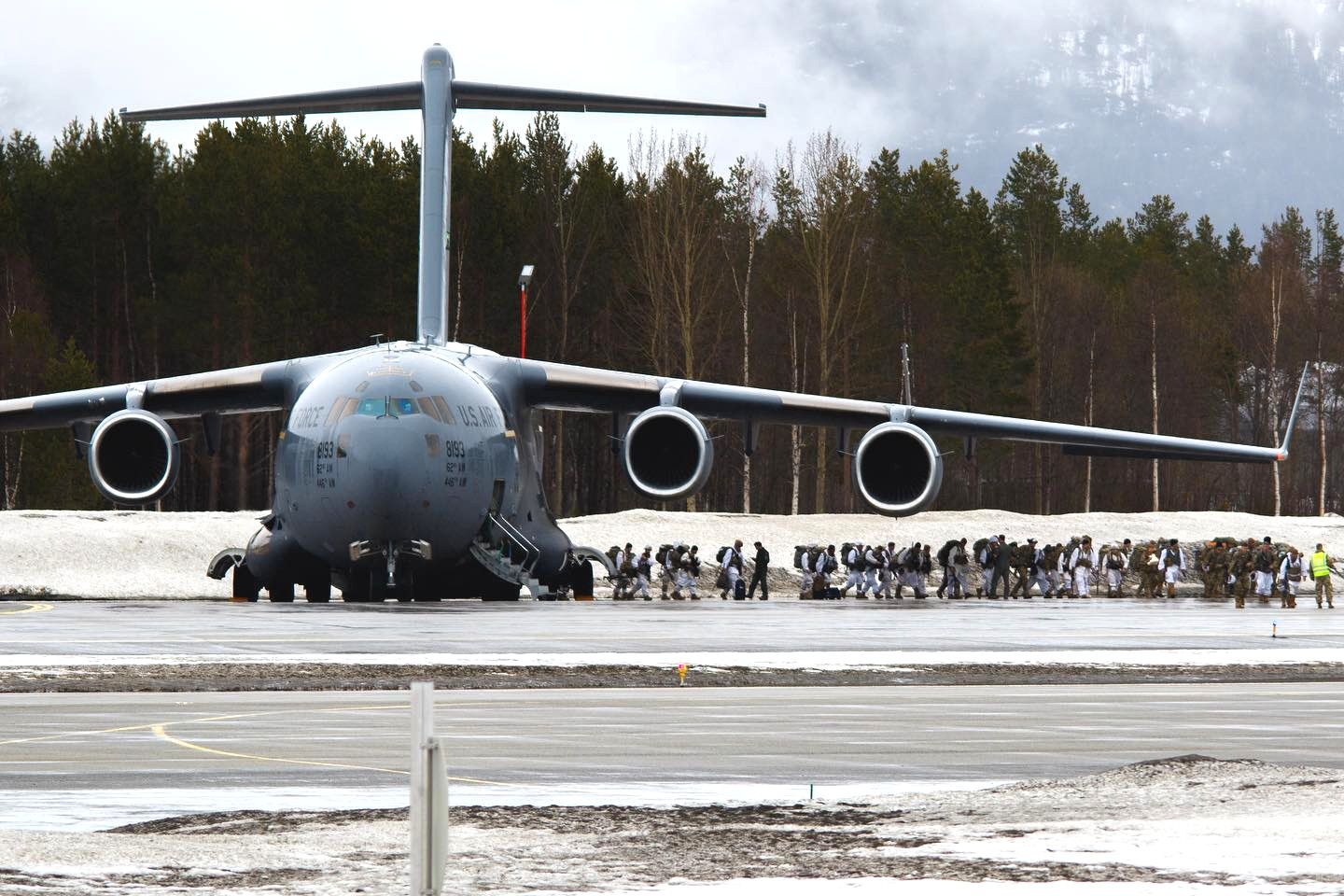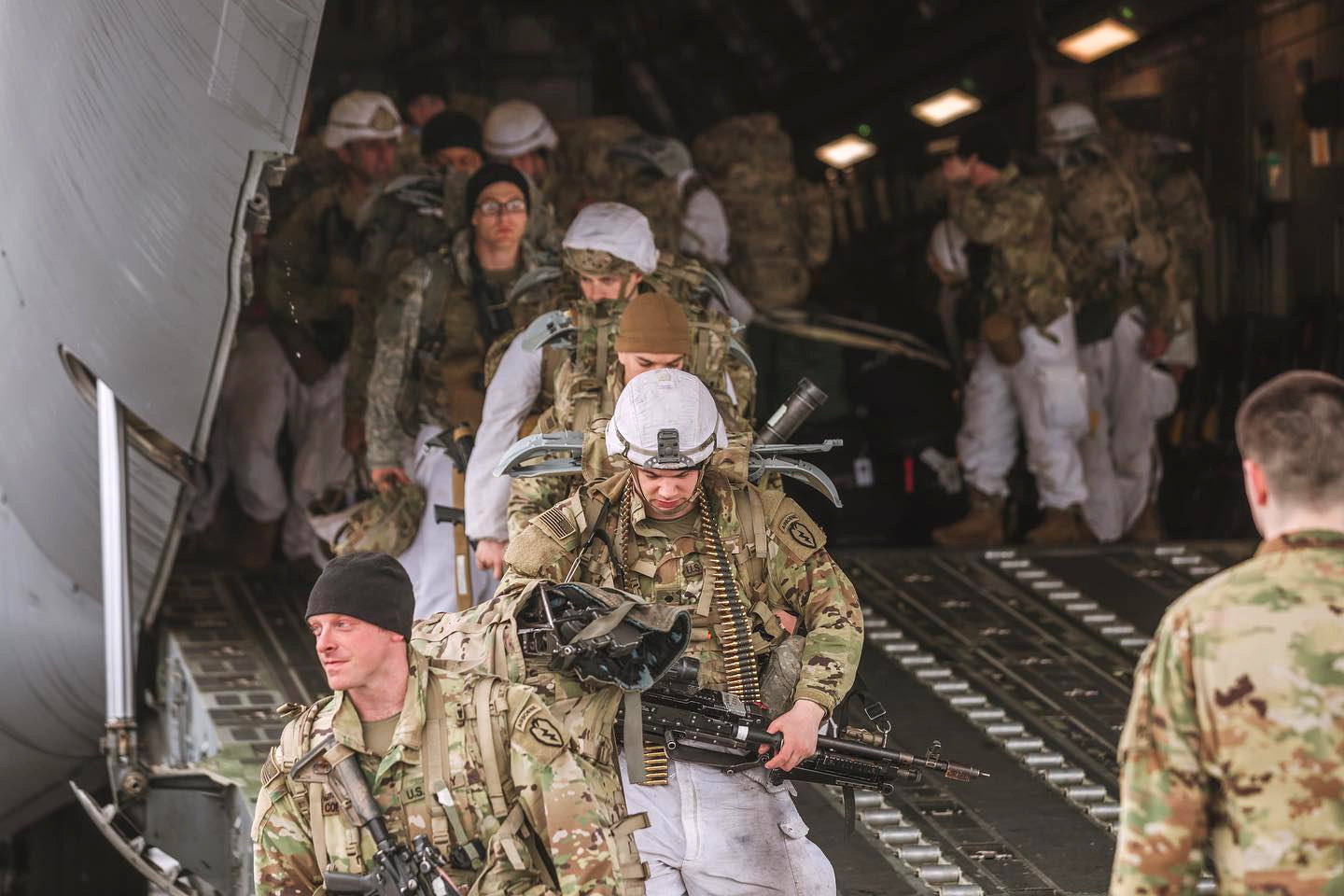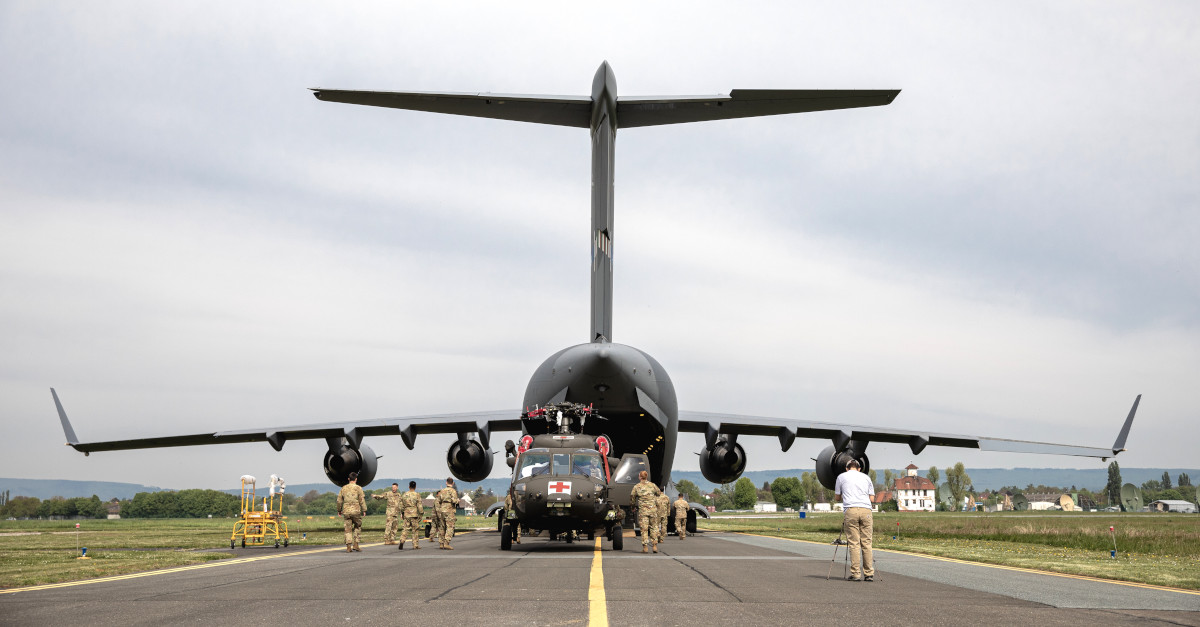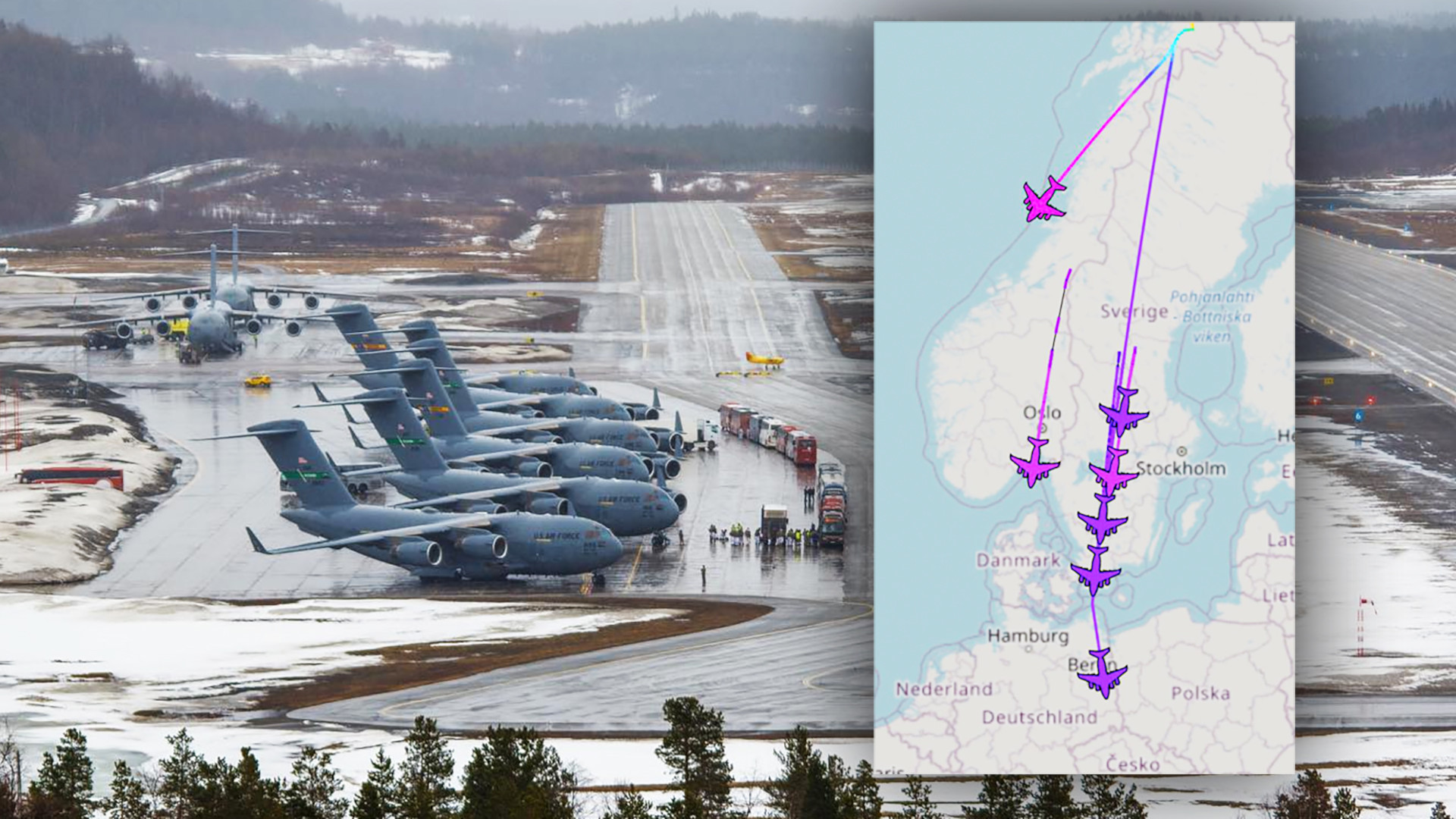With the United States and the rest of NATO still in the midst of the worst security crisis in Europe in decades surrounding Russia’s invasion of Ukraine, any unusual air activity on the part of the alliance’s members is bound to draw attention. Such was the case today when flight trackers using online tracking software suddenly showed at least eight U.S. Air Force C-17A Globemaster III airlifters departing a base in northern Norway in quick succession and then flying southward.
Multiple Air Force C-17As criss-cross Europe every day on various missions, but it is unusual to see a mass formation southbound from Norway. As it turns out, these sorties – which used the callsigns Reach 741, 742, 743, 744, 745, 746, 747, and 748 – are tied to an annual U.S. military-led exercise called Swift Response. This year’s iteration includes a huge airborne operations component that will see near-simultaneous paratrooper drops in four different countries on or about May 13. A total of 9,000 personnel from 17 countries, including 2,700 troops from the United States, will take part in Swift Response 2022.
The Norwegian Armed Forces, or Forsvaret, released pictures today showing eight U.S. Air Force C-17As at Bardufoss Air Station in far-northern Norway. The aircraft brought in elements of the U.S. Army’s Alaska-based 4th Brigade Combat Team (Airborne), 25th Infantry Division (4/25th Infantry), with them for Swift Response. The airlifters flew direct from Alaska to Norway over the North Pole.


Exactly where the aircraft went after that and why is not entirely clear. Online flight tracking software showed one aircraft appear to head southwest across Norway and then out into the North Sea, possibly headed toward the United Kingdom. The other seven jets flew south over Norway and Sweden, then crossed the Baltic, and continued on their way through the airspace of various northern and central European NATO members. That at least six of the airlifters passed through Swedish airspace is notable given that the country is not an alliance member, but is now moving in that direction in light of the Russian invasion of Ukraine.
A number of the C-17s disappeared from the online flight tracking software as they passed over Slovenia, but the final destination of at least some of them appears to have been in northern Italy.
While we know that the initial arrival of these eight C-17s in Norway was directly related to Swift Response, The War Zone cannot yet say with absolute certainty what it is that we observed after the aircraft headed south. However, all of this, especially the arrival of at least some of the C-17s in Italy, all makes sense in the context of the broader exercise.
“The exercise begins when the 4th Brigade Combat Team (Airborne), 25th Infantry Division leaves Alaska and flies over the North Pole to Norway, according to a May 2 press release from U.S. Army Europe and Africa, which oversees virtually all Army activities on both of those continents and is leading the exercise. “The flight, and subsequent airborne jump into Norway, will demonstrate the unit’s ability to conduct arctic defense operations with Allies and partners in the Arctic High North.”

“At nearly the same time, paratroopers from the 173rd Infantry Brigade (Airborne) and 82nd Airborne Division, and several allied airborne units, will conduct separate JFEs [Joint Forcible Entries] into Latvia, Lithuania, and North Macedonia,” it continues. “Once the airborne assaults are complete, each brigade task force will conduct on-the-ground tactical operations and follow-on training, to include rotary wing deep-strike attacks, air-assault operations, live-fire training and field-training exercises.”
The 173rd is based at Caserma Ederle in the northern Italian city of Vicenza. The 82nd Airborne Division is based at Fort Bragg in North Carolina. Pre-positioning the C-17s in Italy, as well as other locations in Europe, would put them in place to load up U.S. and allied paratroopers for the upcoming drops.

In addition to carrying the contingent from 4/25th Infantry to Norway, these aircraft could have brought in additional supporting personnel and equipment that they need to distribute to various bases, as well. As part of the exercise, airlifters are expected to conduct aerial resupply drops to airborne forces after they land, too.

It is also possible, but far less likely, that one or more aircraft were re-tasked to other missions unrelated to Swift Response after depositing the Army paratroopers in Norway. We have reached out to Air Mobility Command (AMC) and US Air Forces in Europe (USAFE) for more information.
Regardless of exactly how these C-17s will factor into the exercise, this year’s Swift Response is set to be a major show of both U.S. and NATO contingency response capabilities. Though planning for Swift Response began in 2021, before Russia invaded Ukraine, it would have already come amid heightened tensions between those two countries.
In particular, the massed airborne operations, including significant numbers of coordinated C-17 flights across Europe, will almost certainly be seen as a signal in Moscow no matter what. The Russian government regularly criticizes NATO’s support for the Ukrainian government and the alliance, and the U.S. military in particular, has made significant use of airbridges to help deliver copious amounts of military aid. In addition, even before Russian troops rolled into Ukraine in February, NATO members were deploying additional forces to the alliance’s eastern boundaries to help deter any potential aggression further west.

For the U.S. military, Swift Response 2022 will be an important demonstration of airborne capabilities more generally, with elements from all three of the Army’s main conventional paratrooper units – 82nd Airborne, 173rd Airborne Brigade Combat Team, and 4/25th Infantry – taking part. Though there is an almost never-ending debate about the utility of airborne forces in future high-end conflicts, especially against near-peer opponents with extensive integrated air defense networks, such as Russia or China, the Army continues to invest heavily in these units. The 82nd Airborne remains the service’s go-to force for responding to all manner of major contingencies worldwide and the 173rd provides a similar forward-deployed component in Europe.

Just last week, the Army revealed that it would take 4/25th Infantry, one of the service’s primary contingency response forces in the Pacific region, and combine it with other elements under a new airborne division headquarters in Alaska. Many details still have yet to emerge about the complete plan for transitioning U.S. Army Alaska (USARAK) into the reborn 11th Airborne Division, but the decision clearly underscores the service’s continued view that paratroopers have an important role to play in all sorts of future conflicts and other crises.
All told, no matter where U.S. Air Force C-17As supporting Swift Response end up flying from in the end, or how many of them are involved, they are set to take part soon in a major display of the U.S. military’s ability, as well as that of NATO collectively, to insert large numbers of troops and equipment across a broad front from the air.
UPDATE: 5:20 PM EST—
U.S. Air Forces in Europe (USAFE) has now put out its own press release and confirmed that C-17As from the 62nd and 446th Airlift Wings at Joint Base Lewis-McChord in Washington State and the 315th and 437th Airlift Wings at Joint Base Charleston in South Carolina dispersed to various locations in Europe today in support of Exercise Swift Response.
“The C-17 cargo aircraft will support the Europe-wide exercise from locations in Italy, Slovenia and the United Kingdom to provide airlift and airdrop capabilities,” according to the press release.
Contact the author: joe@thedrive.com
